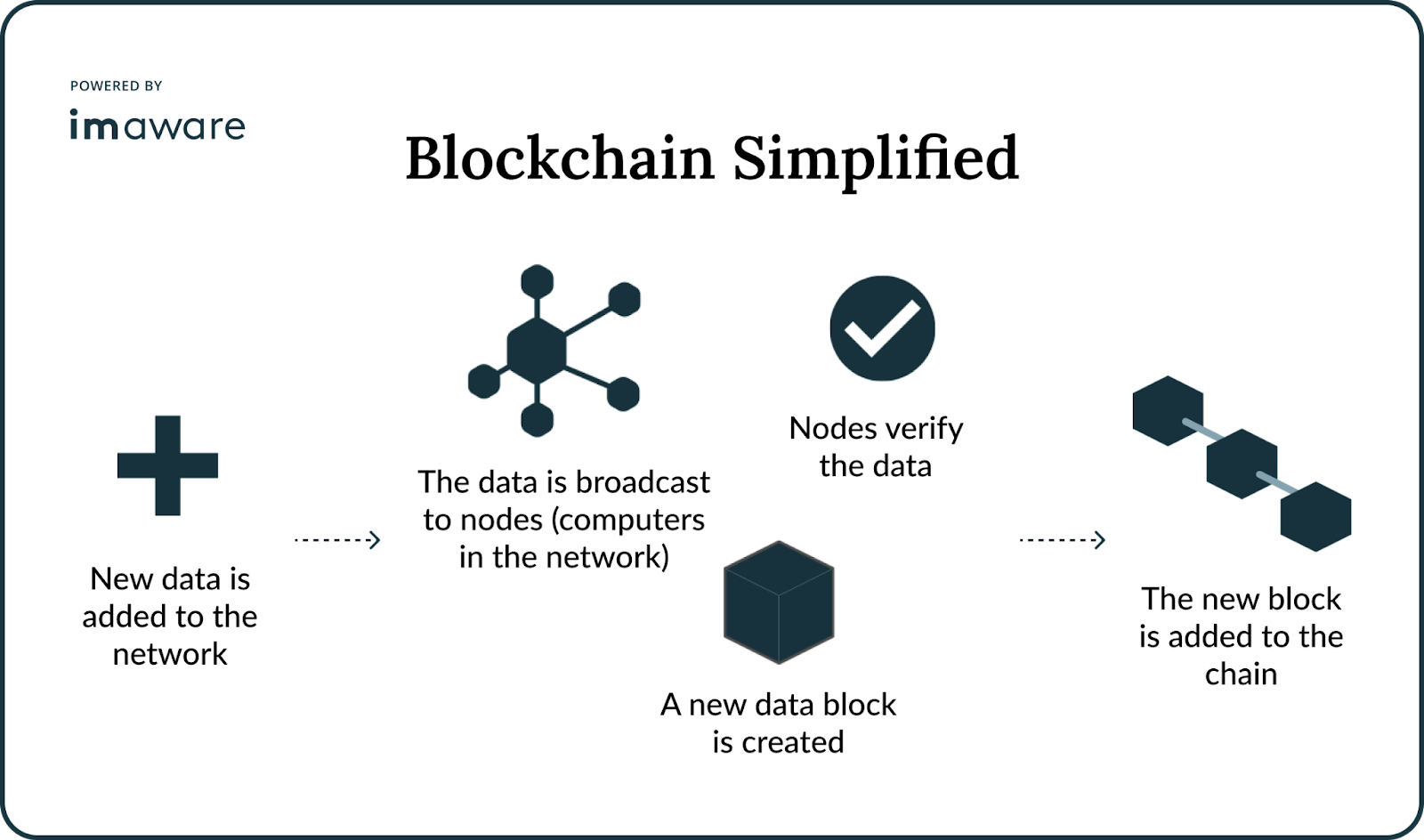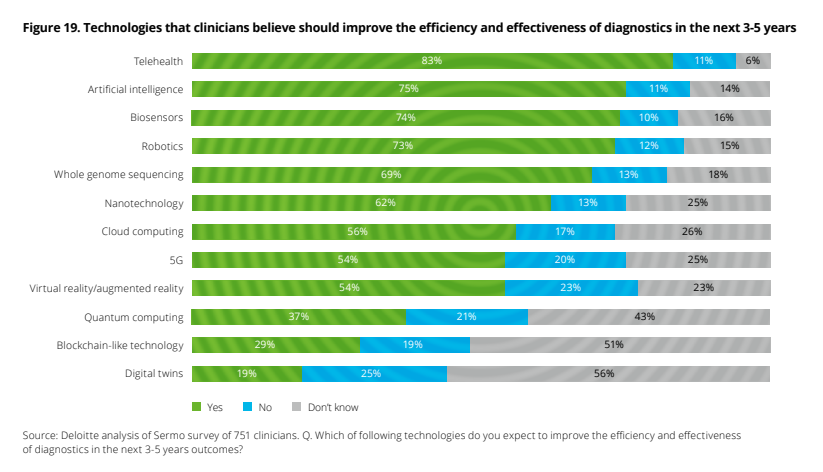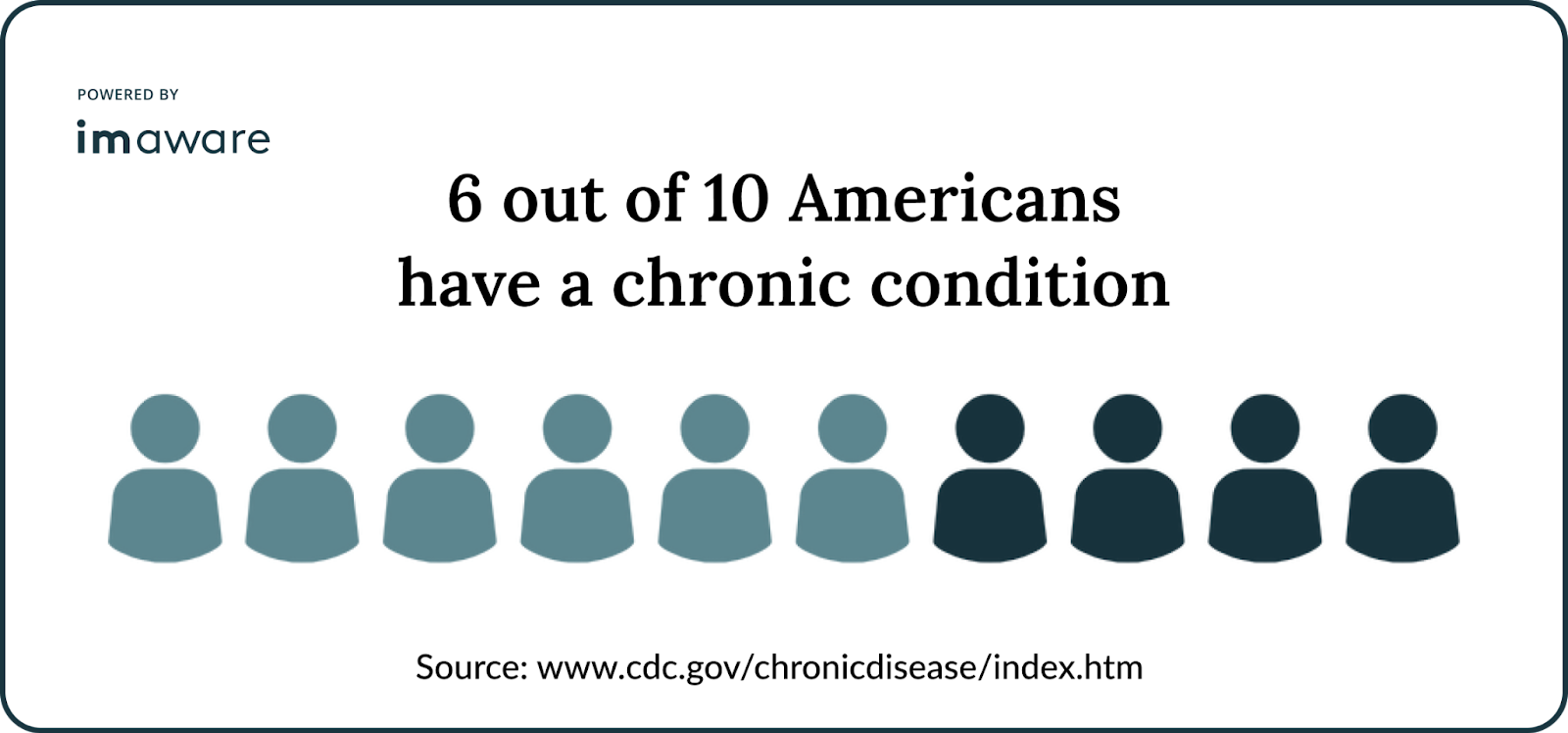The health and wellness industry is experiencing a rapid metamorphosis. The emergence of new digital health technology — alongside constantly shifting patient needs and best care practices — is reshaping how we access healthcare. Remote care is unsurprisingly a central theme within these changes, leading to developments that aim to provide a more accessible and cost-effective healthcare ecosystem.
Out of an overwhelming number of new devices and capabilities within the health and wellness market, here are ten digital healthcare trends to take note of:
1. AI-driven diagnostics and support
Artificial intelligence (AI) is one of the latest technologies influencing industries across the board, from marketing and finance to education, healthcare and lifestyle. AI tools have many different applications because they are simply different types of software that use AI algorithms to perform analyses in order to complete tasks.1 Within healthcare, advanced AI algorithms can quickly comb through various mediums of patient information, such as medical imaging, vitals, medical history and lab results, to provide a more comprehensive picture of a patient's health status.2
Many AI systems have been combined with everyday healthcare tools to assist providers and increase the efficiency with which diagnosis and treatment plans are reached. For example, Aidoc is a system built for radiologists that detects abnormalities in medical scans, such as fractures, aneurysms and pulmonary embolisms.3 Other AI systems, like the portable ATUSA scanner, are capable of taking advanced imaging that healthcare providers can analyze for results.45
In addition to diagnostics, AI may be used for administrative tasks to lessen the load on providers. Healthcare Chatbots and Virtual Assistants can help with medication management, scheduling appointments based on a diagnosis, and even answering basic medical queries.
As with many new forms of technology becoming commonplace, there are still challenges to overcome. For example, since AI-driven diagnostics and support rely heavily on personal health data, ensuring this system can access enough high-quality data is essential.6 Developing additional standards and regulations will be a necessary and crucial aspect of growing AI capabilities across more than just the healthcare landscape.
2. Big data analytics for population health
Big data analytics is the process of using large amounts of data to identify trends and correlations that help individuals make informed decisions.7 In a healthcare context, this means using health data to improve population health, such as predicting disease outbreaks, reducing health spend and optimizing treatment pathways using evidence-based strategies.8
This technology can monitor up-to-date health data from sources like electronic health records (EHRs), social media, wearables and public health reports to detect disease outbreaks and track the spread of infections. Genomic data can even be used to pinpoint genetic variations linked to specific diseases or drug responses within a population.9 Such research helps identify people at higher risk of certain conditions, further supporting preventative health efforts.
Analyzing large datasets can highlight health trends across specific populations and direct public health efforts from the government and other agencies. This information supports resource allocation, intervention strategies and preparation for public health emergencies. It also sheds light on health disparities and social factors' impact on health outcomes.
By analyzing historical and current health data in combination with large-scale studies on trends, interventions and outcomes, big data analytics can create predictive health models and help with public health research.
3. At-home health tests
At-home health testing is a crucial part of remote diagnostics and patient monitoring. By bringing the lab to the patients, patients and providers can avoid many barriers that slow the diagnostic process, such as in-person lab accessibility and wait times. A survey from a 2022 Deloitte report found that 93% of clinicians believe new diagnostic technologies will increase the speed at which they can make a diagnosis.10
At-home health testing also brings more health awareness and power to individuals. People will no longer need to receive a healthcare provider's prescription for specific health testing — they can buy and administer the test themselves.
Beyond primary care, at-home tests can be used to optimize user health and, as a result, have become an integral part of providing a personalized yet remote experience within the health and wellness market. From customized nutrition and supplements to fertility and postpartum services, many companies are discovering ways to offer a more targeted user experience through specific biomarker test panels. The at-home test biomarker capabilities are broad, especially when test samples are sent to and analyzed within reliable labs.
Imaware offers a solution to companies looking to introduce the benefits of this healthcare technology to their business. With an established line of direct-to-consumer at-home health tests already available, imaware's business-to-business side provides a white-label health test experience for partners, including an extensive list of biomarkers, gold standard labs, physician-reviewed results, patient portal and online support.
4. Personalized medicine and genomics
Genomics is the study of a person's genes, including how they interact and how they are affected by one's environment.11 According to the National Human Genome Research Institute, roughly two to 40 billion gigabytes of data are generated yearly.12 Genomic data is being leveraged for enhanced therapeutic effectiveness by tailoring treatment plans and medication to individual patients.
Advancements in genomics are groundbreaking for personalized medicine as they provide insight into the differences between individuals on a molecular level, which in turn allows professionals to make individualized predictions about someone's risk of health conditions and what preventative measures will be most effective.13 One method, DNA sequencing, can even identify genetic variations and mutations related to specific diseases.14
Pharmacogenomics — the study of how different genes respond to drugs — enables researchers and providers to evaluate how a person may react to certain medications.15 With this awareness, treatment plans, including drug types and doses, can be designed to suit each individual best. This technology also holds promise for treating genetic disorders by correcting or replacing faulty genes.
While this information can be groundbreaking, due to the incredibly sensitive nature of it, it comes with the risk of data misuse. One prominent concern is how this technology may infringe on the privacy of individuals and their genetic relatives.16 Appropriately addressing and managing such issues will be essential to the future applications of this technology.
5. Robotics in surgery
What’s a future technology list without robots? Robotic systems are a valuable commodity within the surgical sector. Robotic surgical systems can use smaller incisions and execute intricate maneuvers with high precision and accuracy.17 Smaller incisions result in less invasive procedures, often leading to faster patient recovery and shorter hospital stays.18 Thanks to the higher levels of dexterity and stability, robotic surgical systems are often used for procedures requiring finer manipulations, like microsurgery or suturing hard-to-reach areas. Advanced surgical systems with 3D high-definition visualization enable surgeons to see surgical sites in greater detail. Finally, unlike humans, robots do not tire from long and arduous surgeries, reducing fatigue-related physical restrictions.
Robotic systems can also gather educational data during surgery to help refine techniques and enhance training. These systems are already in use in different fields like urology, gynecology, cardiology and oncology and will undoubtedly continue to evolve across more specialties.19
While initial costs are pretty high, advancements and broader adoption of robotic aspects will hopefully lead to reduced costs and increased accessibility over time. Like the other digital health trends, additional regulatory standards will be necessary as robotic surgery becomes commonplace.
6. Blockchain for medical data security
Blockchain is a shared, immutable ledger or database for recording data, allowing people to track, share and verify data transactions securely and transparently. The basic process involves new data being added to a network, which is broadcast to nodes (computers or servers in the network) and verified before the new block of data is added to the chain.20

Blockchain's primary attribute is providing security and data integrity regarding sensitive information, which is great for quickly and safely sharing patient data between providers and systems. This also gives patients greater control over their health data by permitting specific healthcare providers to access their information. With the addition of specific encryptions and other computing services, patients and providers can gain complete control over their data, including tracking any attempts to access or tamper with it.21
In addition to helping patients manage their data, blockchain can boost clinical trial research. By recording immutable data that can easily be verified and audited, blockchain enhances the transparency and data integrity of clinical trials, thereby increasing the validity of results.
7. Cloud-based EHRs and health data storage
In a 2018 survey conducted by The Harris Poll, 63% of physicians believed electronic health records (EHRs) led to generally improved patient care.22 A cloud-based EHR is a software storage system for patient health records using a special remote server. Adopting cloud-based EHRs makes managing patient data seamless, among other significant benefits, such as:23
- Centralized storage: Cloud-based EHRs store patient health data, including medical history, test results and physician notes, in a central and secure location accessible to providers in different places. Digital access to up-to-date patient information is crucial as patient care services become increasingly remote.
- Enhanced care efforts: Similar to the benefits of utilizing blockchain, cloud-based EHRs enable providers to coordinate care efficiently. With this tech, multiple healthcare providers can securely share, access and update patient data concurrently, reducing the risk of duplicate or missed actions.
- Empowered patients: Patients with better access to their data gain a stronger understanding of the importance of their health journey. This understanding also improves communication between patients and providers, increasing patient satisfaction and loyalty.
- Streamlined administration tasks: Cloud-based EHRs can make it easier to schedule appointments, submit insurance claims, request prescriptions and more. Many automated tasks are more accurate and efficient, saving time and money.
- Secured data: Cloud service providers implement robust data security measures like encryption and multi-factor authentication, as well as valuable recovery mechanisms like backup systems, to keep patient health records safe.
8. Telemedicine and virtual care expansion
Care platforms have joined the rise in virtual technology. Pre-COVID-19 pandemic, telemedicine was available and tentatively adopted across the healthcare system. Once the pandemic hit, however, this gradual adoption changed to a much more rapid integration as healthcare providers scrambled to find remote solutions for patients.
Not only do virtual care platforms provide a solution during periods of social distancing, but they also supply a broader range of accessibility. In the American Medical Association 2021 Telehealth Survey, over 80% of clinician respondents indicated that patients have gained better access to care since introducing telehealth services.24 Whether it is a geographical issue, mobility restrictions, time limitations, or lack of regional providers, telehealth is a solution for many who do not require immediate physical intervention. Possible uses for telehealth are expanding — currently, the most common services include treatment, screening or diagnosis, post-hospitalization care, monitoring, chronic disease management, specialty care and mental health.25
In addition to accessibility, virtual care can reduce costs. For example, United Healthcare estimates that patients using their telehealth services instead of a visit to Urgent Care or the ER can save around $130 and $2,000, respectively.26 Telehealth can also lead to more efficient diagnoses — according to a 2022 report by Deloitte, clinicians believe the top technologies to improve the efficiency and effectiveness of diagnostics in the next three to five years are telehealth, artificial intelligence, biosensors, robotics and whole genome sequencing.27

More accessibility, reduced costs, and better health outcomes can influence patient engagement and loyalty, resulting in higher patient satisfaction rates.28
9. Smart devices for remote patient monitoring
Smart devices have become mainstream, but their capabilities as remote patient monitoring devices are just getting started. The health data cultivated by smartwatches, patches, and even toilets can reduce the need for in-person check-ups and testing.29 Able to continuously monitor and upload patient vitals, wearable devices and sensors connected to the internet can strengthen patient care plans. For example, certain devices can track and identify alarming health data, like abnormal cardiac rhythms,30 in order to notify individuals to seek immediate medical attention.
Like at-home testing, the application of these devices is also growing within the preventative health and wellness industry. New smart sensors, equipment, body composition scanners and other gadgets are being adapted to create optimal at-home personal training sessions and healthy lifestyle coaching experiences. Keeping a close eye on patient vitals makes it easier to catch health issues and make changes before they can decline further.
Smart devices can capture, monitor and analyze data to provide insightful results. This new and developing avenue for cultivating personal health data is exciting for patients, providers and researchers alike.
10. Digital therapeutics
Digital therapeutics are evidence-based and clinically-driven software products for treating and managing various health conditions.31 Within the expanding world of digital health, digital therapeutics is at the forefront with $8.9 billion in funding in 2021 — a 134% increase from the previous year, according to McKinsey & Company.32 Digital therapeutics helps with areas telehealth does not always satisfy — areas like prevention, chronic condition management and mental health support.

According to the CDC's National Center for Chronic Disease Prevention and Health Promotion, 60% of Americans have at least one chronic condition, including diabetes, cancer and cardiovascular disease.33 The burden of these conditions is growing, unsurprising considering current rates of nonadherence — around 40% to 50% of patients prescribed medications for conditions like diabetes or hypertension fail to adhere.3435 Digital therapeutics can assist with medication adherence as well as frequent monitoring and personal coaching, promoting better health and reducing costs. Chronic conditions are a leading driver of America's $4.1 trillion annual healthcare expenditures; around 90% are attributable to chronic and mental health conditions.36
Another critical area that benefits from digital therapeutics is the mental health sector. Mental health digital therapeutics exist to provide healthcare practitioner-validated interventions that help treat and manage mental and behavioral disorders.37 Digital therapeutics that require prescriptions from healthcare providers and FDA authorization, like prescription digital therapeutics (PDTs), offer an essential option for addressing many mental healthcare challenges.38
Digital therapeutics shine among healthcare trends by providing the evidence-based approach and professional oversight individuals want and need.
Summary
The future of healthcare delivery and patient outcomes is being transformed by many health technology trends. Telehealth, digital therapeutics and remote patient monitoring devices bring more connection and awareness to patients and providers. Advancements like AI-driven diagnostics, big data analytics, blockchain and cloud-based EHRs are providing more efficient and secure ways to analyze, store and share these new aspects of healthcare data. More specific elements like genomics and robotics are changing the approaches of specialized fields like personalized medicine and surgery. These developments, alongside many more, offer endless possibilities for the future of health and wellness care.
















.svg)




